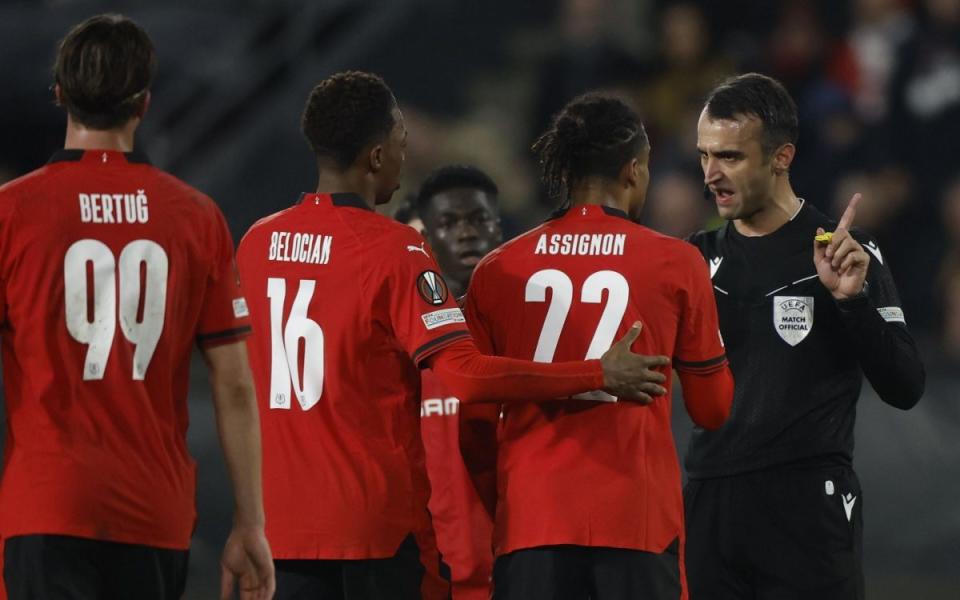Watch: Rennes’ dramatic equaliser ruled out by obscure football law

Bafflement more than anger subdued Rennes’ fans euphoria after their third equaliser of the night against Villarreal was ruled out due to an obscure law in their final Europa League match. The home side, who had led Group F at kick-off and needed a point to avoid second place and a play-off against a Champions League outcast, seemed resigned to their fate after Dani Parejo put Villarreal 3-2 ahead after 80 minutes to move above them, undoing all their valiant efforts to claw their way back from 1-0 and 2-0 down.
But 21 minutes later, in the 11th minute of stoppage time, when the right-back Lorenz Assignon lashed a right-foot shot past Pepe Reina into the bottom left corner, the home fans celebrated the draw at Roazhon Park which would have given them first place and a bye into the last 16 with appropriate abandon. The referee and his two assistants had seen no infingement and yet the game was halted for a Var check. Initially, it seemed, he was checking for an offside in the build-up when the cross that instigated the bout of penalty box pin-ball was struck.
Sam Matterface, commentating on TNT Sports, quickly pointed out that Assignon was demonstratively onside when the ball came to him and professed his profound bewilderment when the Turkish referee, Atilla Karaoglan, acting on the advice of his Italian Var, Massimiliano Irrati, ruled the goal out and awarded Villarreal a free-kick. Confused by the screen caption showing that Var was conducting an offside check, he could not see any offence to justify Rennes being denied the goal.
Rennes thought they had scored to secure a place in the #UEL last 16, deep into added time, but VAR had other ideas 😳
Can anyone work out why this goal was disallowed? 🤯 pic.twitter.com/WHsxtuEt6I— Football on TNT Sports (@footballontnt) December 14, 2023
Yet, as the referee explained to Villarreal’s Ben Brereton Díaz, the Var had spotted something two phases earlier in the move when Rennes had been awarded a free-kick 25 yards out. Understandably, with only seconds to go, Enzo Le Fée had gone for goal, swerving his free-kick over the wall and crashing it into the crossbar. He hit it with such force that it rebounded straight back to him and had a second nibble at deliverance, trapping the ball before trying to thread a left-foot pass to Martin Terrier. He did not find his target and the ball was played out to the left from where it was centred and Assignon pounced on a defender’s headed clearance.
The offence, though, had been committed when Le Fée killed the ball when it flew back to him. Law 13, which regulates free-kicks, states: “If, after the ball is in play, the kicker touches the ball again before it has touched another player an indirect free kick is awarded.” Just as you cannot tee yourself up from a free-kick, another player has to touch the ball before the taker can play it again. It’s the same for penalties, as Peter Reid found out at Elland Road in 1991 when player-manager of Manchester City. Reid smacked the penalty into the post then hooked in the rebound. He, unlike Le Fée and Matterface, immediately recognised what had happened and why it was disallowed.
For Rennes’ fans, however, there was no explanation either from the Var or the commentators. Given it is such a rare occurrence, Var can be forgiven for not having a templated caption and the referee a universally understood signal for it, but there is little excuse for players and pundits not to know the laws especially one that isn’t as obscure as they seemed to think.
Rennes may have been bemused but they can take some solace from second place and the knowledge that, newly enlightened, this kind of lightning should not strike twice.

